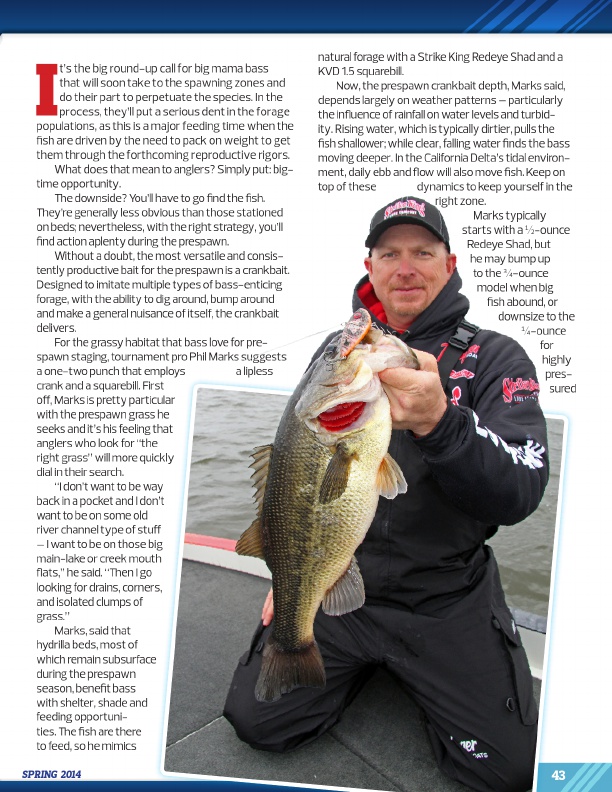
I
t’s the big round-up call for big mama bass
that will soon take to the spawning zones and
do their part to perpetuate the species. In the
process, they’ll put a serious dent in the forage populations, as this is a major feeding time when the
fish are driven by the need to pack on weight to get
them through the forthcoming reproductive rigors.
What does that mean to anglers? Simply put: big-
time opportunity.
The downside? You’ll have to go find the fish.
They’re generally less obvious than those stationed
on beds; nevertheless, with the right strategy, you’ll
find action aplenty during the prespawn.
Without a doubt, the most versatile and consis-
tently productive bait for the prespawn is a crankbait.
Designed to imitate multiple types of bass-enticing
forage, with the ability to dig around, bump around
and make a general nuisance of itself, the crankbait
delivers.
For the grassy habitat that bass love for pre-
spawn staging, tournament pro Phil Marks suggests
a one-two punch that employs
a lipless
crank and a squarebill. First
off, Marks is pretty particular
with the prespawn grass he
seeks and it’s his feeling that
anglers who look for “the
right grass” will more quickly
dial in their search.
“I don’t want to be way
back in a pocket and I don’t
want to be on some old
river channel type of stuff
– I want to be on those big
main-lake or creek mouth
flats,” he said. “Then I go
looking for drains, corners,
and isolated clumps of
grass.”
Marks, said that
hydrilla beds, most of
which remain subsurface
during the prespawn
season, benefit bass
with shelter, shade and
feeding opportuni-
ties. The fish are there
to feed, so he mimics
SPRING 2014
natural forage with a Strike King Redeye Shad and a KVD 1.5 squarebill.
Now, the prespawn crankbait depth, Marks said, depends largely on weather patterns – particularly the influence of rainfall on water levels and turbid- ity. Rising water, which is typically dirtier, pulls the fish shallower; while clear, falling water finds the bass moving deeper. In the California Delta’s tidal environ- ment, daily ebb and flow will also move fish. Keep on
top of these
dynamics to keep yourself in the
right zone.
Marks typically
starts with a ½-ounce
Redeye Shad, but
he may bump up
to the ¾-ounce
model when big
fish abound, or
downsize to the
¼-ounce
for
highly
pres-
sured
43